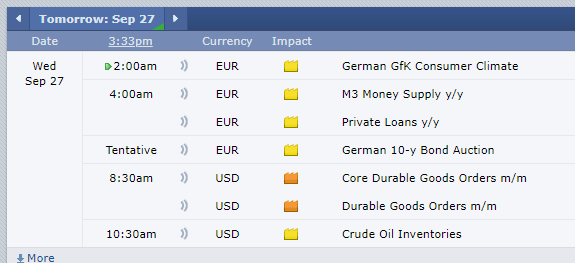Understanding psychological biases at work that can affect your trading plan + Levels for Sept. 27th
Posted By:- Ilan Levy-Mayer Vice President, Cannon Trading Futures Blog
Understanding psychological biases at work that can affect your trading plan
List generated by By John Thorpe, Senior Broker
Technical analysis is not a flawless science, and it is susceptible to various biases that can impact trading decisions and performance. Recognizing and addressing these biases is essential for becoming a more disciplined and successful trader.
Here are some common technical analysis biases and strategies to avoid or overcome them:
- Confirmation Bias:
- Bias: This occurs when traders only seek or give importance to information that confirms their existing beliefs or positions.
- Avoidance Strategy: Actively seek out information and technical signals that might contradict your initial analysis. Be open to changing your view based on objective data rather than personal bias.
- Overfitting Bias:
- Bias: Overfitting happens when traders use too many technical indicators, parameters, or complex strategies to fit historical data perfectly, but these strategies may not perform well in future markets.
- Avoidance Strategy: Keep your technical analysis simple and use a limited number of well-established indicators and patterns. Focus on robust strategies that have demonstrated reliability over time.
- Recency Bias:
- Bias: Traders tend to give more importance to recent price movements and patterns, assuming they will continue, while ignoring longer-term trends or historical context.
- Avoidance Strategy: Consider a longer time horizon and look at historical price data to gain perspective. Avoid making impulsive decisions based solely on recent price action.
- Anchoring Bias:
- Bias: This bias occurs when traders fixate on a specific price level or a reference point, often the entry price, and refuse to adjust their positions or exit strategies accordingly.
- Avoidance Strategy: Regularly reassess your positions and set stop-loss and take-profit levels based on current market conditions rather than anchoring to an arbitrary point.
- Availability Bias:
- Bias: Traders might rely too heavily on readily available information or recent news, leading to biased analysis and decision-making.
- Avoidance Strategy: Seek a variety of information sources and avoid making hasty decisions based solely on the latest news. Maintain a broader perspective on market fundamentals.
- Gambler’s Fallacy:
- Bias: Traders may believe that past events, like a series of losses, increase the likelihood of future events, such as a win, even though markets are not governed by probability in the same way as games of chance.
- Avoidance Strategy: Trade based on sound technical and fundamental analysis rather than expecting a change in luck. Each trade should be evaluated independently.
- Emotional Bias:
- Bias: Emotional responses, such as fear and greed, can cloud judgment and lead to impulsive decisions.
- Avoidance Strategy: Develop a trading plan with predefined entry and exit points, risk tolerance, and position sizing. Stick to your plan and avoid letting emotions drive your actions.
- Hindsight Bias:
- Bias: After a trade has concluded, traders may believe they knew the outcome all along, leading to overconfidence in their abilities.
- Avoidance Strategy: Keep a trading journal to record your analysis, decisions, and outcomes. This will help you learn from your experiences and avoid hindsight bias.
- Self-Attribution Bias:
- Bias: Traders may attribute successful trades to their skill and unsuccessful trades to external factors or bad luck.
- Avoidance Strategy: Be honest with yourself about your strengths and weaknesses as a trader. Analyze both winning and losing trades to identify areas for improvement.
- Anxiety Bias:
- Bias: Anxiety can lead to hesitation or overtrading, causing traders to miss opportunities or make impulsive decisions.
- Avoidance Strategy: Implement stress-reduction techniques, maintain discipline, and stick to a well-defined trading plan to mitigate anxiety-related biases.
Being aware of these biases is the first step toward becoming a more rational and disciplined trader. It’s also beneficial to continuously educate yourself, practice risk management, and seek feedback from mentors or peers to improve your trading skills and reduce the impact of these biases on your performance.
Trading Futures, Options on Futures, and retail off-exchange foreign currency transactions involves substantial risk of loss and is not suitable for all investors. You should carefully consider whether trading is suitable for you in light of your circumstances, knowledge, and financial resources. You may lose all or more of your initial investment. Opinions, market data, and recommendations are subject to change at any time when it comes to Futures Trading.
Futures Trading Levels
09-27-2023

#ES, #NQ, #YM, #RTY, #XBT, #GC, #SI, #CL, #ZB, #6E, #ZC, #ZW, #ZS, #ZM, #NG
Improve Your Trading Skills
Economic Reports, Source:

This is not a solicitation of any order to buy or sell, but a current market view provided by Cannon Trading Inc. Any statement of facts here in contained are derived from sources believed to be reliable, but are not guaranteed as to accuracy, nor they purport to be complete. No responsibility is assumed with respect to any such statement or with respect to any expression of opinion herein contained. Readers are urged to exercise their own judgement in trading.












